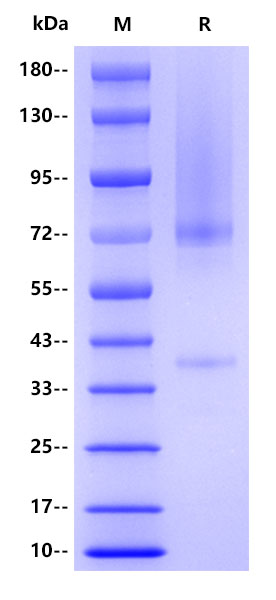Protein sequence(P51654, Gln25-His559, with C-10*His) QPPPPPPDATCHQVRSFFQRLQPGLKWVPETPVPGSDLQVCLPKGPTCCSRKMEEKYQLTARLNMEQLLQSASMELKFLIIQNAAVFQEAFEIVVRHAKNYTNAMFKNNYPSLTPQAFEFVGEFFTDVSLYILGSDINVDDMVNELFDSLFPVIYTQLMNPGLPDSALDINECLRGARRDLKVFGNFPKLIMTQVSKSLQVTRIFLQALNLGIEVINTTDHLKFSKDCGRMLTRMWYCSYCQGLMMVKPCGGYCNVVMQGCMAGVVEIDKYWREYILSLEELVNGMYRIYDMENVLLGLFSTIHDSIQYVQKNAGKLTTTIGKLCAHSQQRQYRSAYYPEDLFIDKKVLKVAHVEHEETLSSRRRELIQKLKSFISFYSALPGYICSHSPVAENDTLCWNGQELVERYSQKAARNGMKNQFNLHELKMKGPEPVVSQIIDKLKHINQLLRTMSMPKGRVLDKNLDEEGFESGDCGDDEDECIGGSGDGMIKVKNQLRFLAELAYDLDVDDAPGNSQQATPKDNEISTFHNLGNVHGGGGSHHHHHHHHHH
12 months from date of receipt, -20 to -70 °C as supplied. 6 months, -20 to -70 °C under sterile conditions after reconstitution. 1 week, 2 to 8 °C under sterile conditions after reconstitution. Please avoid repeated freeze-thaw cycles.
Glypican-3 is a protein that, in humans, is encoded by the GPC3 gene. The protein core of GPC3 consists of two subunits, where the N-terminal subunit has a size of ~40 kDa and the C-terminal subunit is ~30 kDa. GPC3 has been found to regulate Wnt/β-catenin and Yap signaling pathways. GPC3 interacts with both Wnt and frizzled (FZD) to form a complex and triggers downstream signaling. Glypican 3 immunostaining has utility for differentiating hepatocellular carcinoma (HCC) and dysplastic changes in cirrhotic livers; HCC stains with glypican 3, while liver with dysplastic changes and/or cirrhotic changes does not. GPC3 is also expressed to a lesser degree in melanoma, ovarian clear-cell carcinomas, yolk sac tumors, neuroblastoma, hepatoblastoma, Wilms' tumor cells, and other tumors. However, the significance of GPC3 as a diagnostic tool for human tumors other than HCC is unclear.
Immobilized Human Glypican-3 , His tag at 1 μg/mL (50 μL/well) can bind Glypican-3 Recombinant Rabbit mAb (SDT-R032) (S0B2111) with EC50 of 4.856-7.279 ng/mL.

2μg(R: reducing conditions)